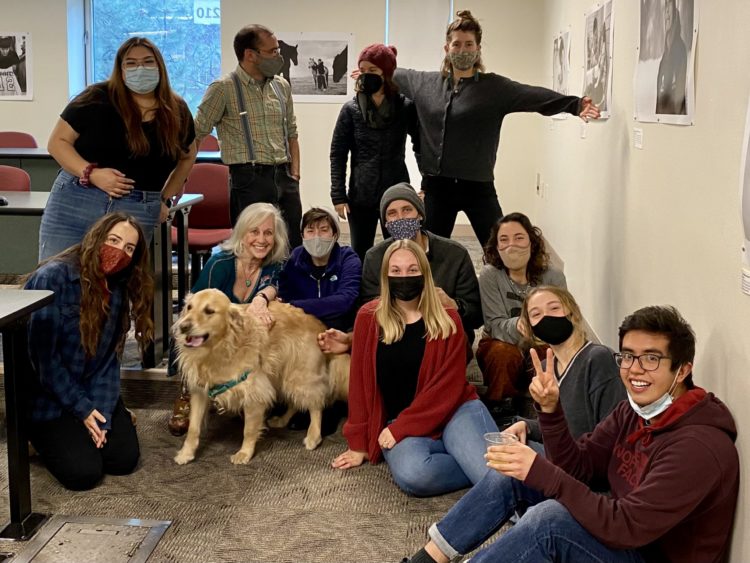EDITOR’S NOTE: Narrative editor Jan Winburn created a class focused on trauma reporting last semester at the University of Montana, where she was the T. Anthony Pollner Distinguished Professor. For the next four Thursdays, we’ll post interviews her students did with John D. Sutter, Moni Basu and Jessica Ravitz, all who worked with Winburn at CNN, and with NPR’s Nate Rott.
What goes on in someone’s brain when the unthinkable happens? How can a reporter do justice to a trauma survivor’s story without doing harm? And what is the value of reporting on loss? How does it balance against the potential of retraumatizing someone?
Those questions and others occupied my journalism students this past semester at the University of Montana, where I taught a seminar called “The Worst Day Ever: Writing about Trauma.”
As someone who spent more than 40 years as a narrative editor in newsrooms, I know these are not just issues for students; similar questions nag experienced reporters — and especially those who are thoughtful about what they do.

At CNN, I dispatched writers across the globe to places where bad things had happened. The reporters on my team were not the first responders bringing you the day’s headlines. They were in pursuit of the “aftermath” stories that introduced you to the human beings who suffered and survived. But often this question hung in the air: What is gained by documenting the worst day in someone’s life?
Early in my career, what I knew about how to approach survivors of a tragedy came from instinct and personal experience. No one in the newsrooms where I worked talked about covering trauma, or the impact of that coverage on victims. But during the past two decades, the profession has worked to improve this coverage, spurred by the establishment of a rich source of research, support and insight, the Dart Center for Journalism and Trauma.
At one time, “trauma journalism” usually meant reporting on war, terrorism and genocide. But thanks in part to the Dart Center, it is widely recognized now that journalists encounter stories of trauma in every news cycle: floodwaters rip a baby from its father’s arms, a baseball team’s bus turns over on the way to a tournament, a protest crowd grows violent.
Add to these the oldest of traumas — race-based atrocities perpetrated on individuals and entire communities — and the relatively new forms of tragedy documented by today’s journalists: mass shootings, police shootings, climate-related disasters and, most recently, the COVID pandemic, which has imposed a large-scale trauma of isolation, dislocation, anxiety and profound loss.
Studying the effects of trauma
My Montana students studied Eli Saslow’s work on the pandemic for The Washington Post. In these deeply reported pieces, he employed the techniques of oral history to showcase “Voices from the Pandemic” in an as-told-to format.
Related stories
Strictly Q&A: John D. Sutter reporting Hurricane Maria
Strictly Q&A: Jessica Ravitz on farmer suicides
Strictly Q&A: Moni Basu on following an earthquake survivor in Haiti
We studied how trauma changes brain chemistry and can affect memory. We learned that a survivor of tragedy craves what has been lost: control. And that a reporter can respond to that need in small but important ways, by asking: Where would you like to be interviewed? Do you want anyone there with you? Can we continue, or do you need a break? We discussed what journalists can do to care for themselves after exposure to violence or tragedy, because vicarious and secondary trauma are real.
But the question that persisted in my classroom was this: Why do we ask survivors to recount their experiences? Is doing so ethically or morally sound?
Every reporter I’ve ever worked with has asked themselves this question again and again. To them, and to my students, I’ve offered these thoughts:
We do not get through our lifetimes without experiencing loss. Trauma is central to human existence. And central to journalism, because it is the journalist’s duty to inform, to give voice not just to opinion, but to people’s lived experience. Sometimes that means illuminating the landscape of tragedy and trauma.
Research has shown that the more information the brain absorbs about someone, the more empathy grows. In other words, deeply told stories that strive to put you in someone else’s shoes spark feelings of empathy. And grief experts say that connection itself is healing.
But with each story, it serves us well to ask this question: What is my purpose?
If you can answer that question, if you can describe what you hope to achieve, then you’ll know why, and whether, to pursue a story.
I’m not talking about a souped-up pitch aimed at convincing a trauma survivor or a victim’s family to talk to you. And I’m not talking about a seemingly lofty purpose that, boiled down, is more about your reflected glory in the storytelling than the experiences of those whose stories you tell.
The “greater good” of a story
Your purpose must emanate from an honest place. You have to believe there is some greater good in telling the story. I once heard a reporter tell a victim’s parents, “I just want people to know who she was. She should be known for more than how she died.” The most indelible advice my class heard about interviewing survivors also spoke to purpose. The advice was this: Don’t leave the person in a dark place. Ask questions that gently move them away from discussion of the trauma: What has given you strength? What brings you joy? What do you want others to know about your loved one?
That wisdom came from Selene San Felice, an Axios reporter based in Tampa Bay, Florida, and it was hard won. In 2018, Selene was at her desk in her former newsroom, The Capital Gazette in Annapolis, Maryland, when five of her colleagues were gunned down.
Selene has found purpose in her experience as both a survivor and a journalist: to help others cover trauma with sensitivity.
To prepare my students for interviewing a survivor, I asked each of them to find a narrative story about trauma that they admired and interview the journalist who produced it. I hoped the assignment would offer insight and reassurance about their roles as chroniclers of tragedy.
For John D. Sutter, reporting on the death toll of Hurricane Maria for CNN meant asking Puerto Ricans to relive the disaster that stole the lives of family members and friends. It meant literally counting bodies in funeral homes and morgues. John reported with a purpose that was both moral and humane: He wanted to hold the government accountable, to expose efforts to hide the scale of the calamity. And he wanted to make known the human loss, individually, to introduce us to the victims and their dreams.
Moni Basu, who followed a survivor of an earthquake in Haiti over the course of a year, found purpose in showing readers how life goes on, with struggle and resilience.
Jessica Ravitz, who asked a Montana farm family to talk about their father’s suicide, hoped to help that family open a conversation in their community about a taboo subject.
Finally, Nate Rott of NPR, who covered the deaths of 19 hotshots in a fire in 2013, talked about bearing witness. Sometimes a reporter’s purpose is as simple, and as difficult, as that.
***
Jan Winburn spent more than four decades working in newsrooms as a narrative editor, writing coach and investigative editor, and now teaches in the University of Georgia’s MFA program in Narrative Nonfiction.



